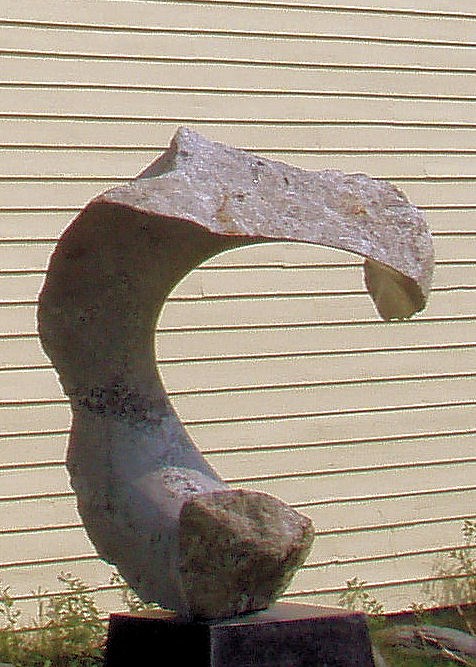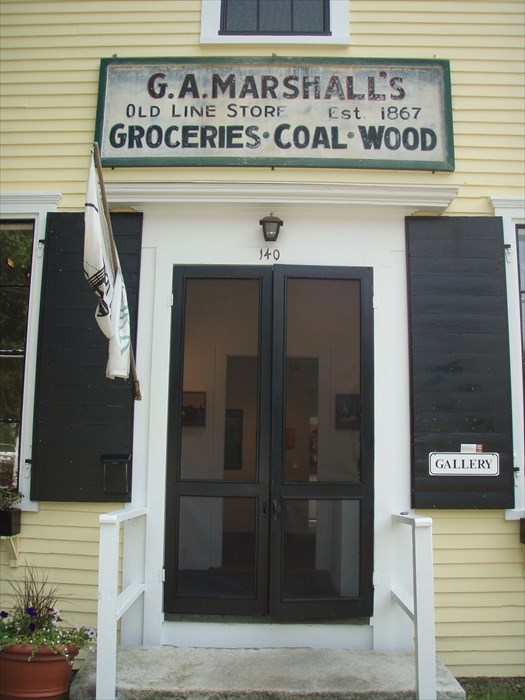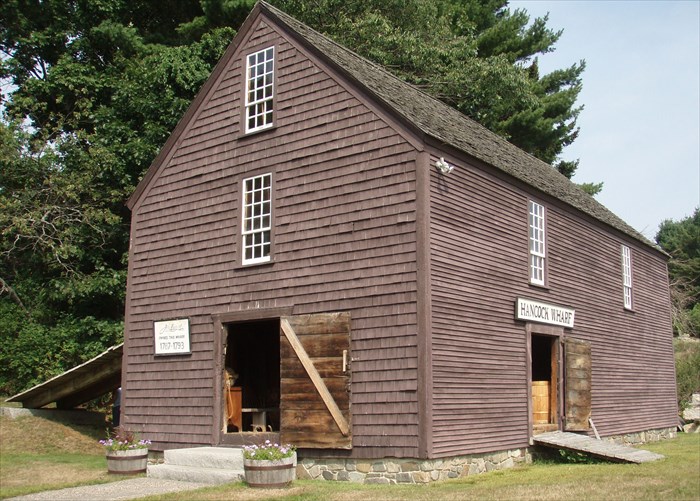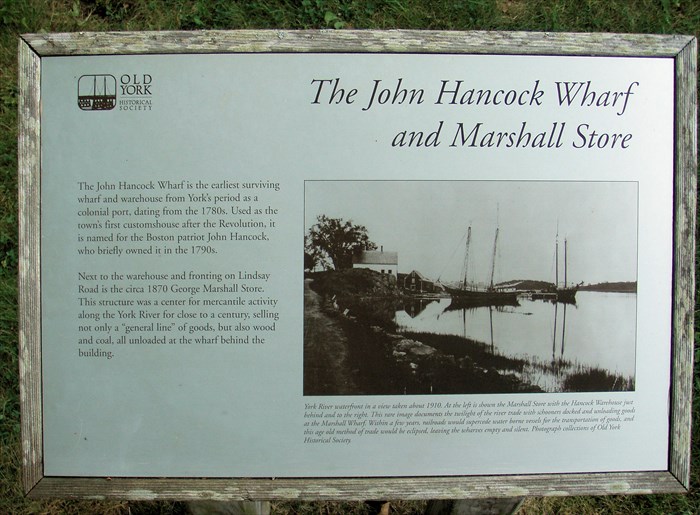
This untitled and unsigned abstract sculpture is about three feet high, mounted on a granite pedestal about 2 ft. high. The sculpture is a piece of rough hewn granite forming a slight spiral. There is no plaque or other identifying marks on the sculpture or base.

George Marshall House (museum)
York, Maine
Dating from 1870, the George Marshall House, is now maintained as a small art museum with modern painting and sculpture on display. There are also several abstract sculptures outside, and historic plaques about the site. These buildings have been placed on the National Register of Historic Places.
On our visit, the warehouse was just open, allowing visitors to wander through the building that has been wonderfully restored with period artifacts so that one has the complete illusion of stepping 300 years into the past. The nearby Marshall House is now an art museum and gift shop, which was also open, but unattended.

G. A. Marshall's
Old Line Store Est. 1867
Groceries . Coal . Wood
York, Maine
Here is the description of this site from the
Old York Historical Society which maintains it along with eight other museums.
The John Hancock Warehouse and George Marshall Store document three hundred years of commercial life along the York River. Of the many wharves and warehouses which fronted the river and York Harbor in the 18th century, the John Hancock Warehouse is the only remaining commercial building from the Colonial period in York. The York River was the town's major "highway" and played a significant role in York history. The river shaped the daily lives of townspeople in the 18th century and gave York a more cosmopolitan outlook and influence than most inland communities of that time.
The exact construction date of the warehouse is not known, but it is thought to date from the 1740s. Local historians cite Thomas Donnell as first owner of the wharf and builder of the warehouse. The Warehouse was later sold to Daniel Bragdon who came into financial difficulties during the Revolutionary War and was forced to borrow from Boston patriot John Hancock, mortgaging his warehouse interest in 1787. When Bragdon died four years later, the property passed to Hancock. John Hancock owned Bragdon's share of the property until his death in 1793.
The warehouse acted as a store and was likely used as the Customs House for the District Port of York. The customs collector collected taxes on ships coming into harbor loaded with china, fabrics, silver, furniture, and tea by way of London and Boston. Coasters that traded at ports from Nova Scotia to Georgia carried mail, grain, and furs. Barrel staves and hoops, tallow, apples and potatoes were exported from York to the West Indies.

John Hancock Wharf (warehouse)
York, Maine
The warehouse passed through several owners before George Marshall bought the site in 1867. Next door, he built the George Marshall Store and sold general merchandise as well as wood, building materials, and coal.
When Marshall died, President Theodore Roosevelt appointed his sister Adaline Marshall acting Collection of Customs for the Port of York. She was the only woman to ever serve that post in the United States. The port of York was closed by President William Howard Taft in 1913, one of his last acts before leaving his office.
Another sister, Katherine E. Marshall, took over her brother's business. When health forced Kate to give up the business in 1954 she turned the "Old Customs House" over to the Newcomen Society in North America. Restoration began in 1956 and was followed by a two-phase restoration in 1979 and 1980 when a new foundation was added and the entire wharf area was built up behind new pilings to protect the building from flooding. Old York acquired the building from the Newcomen Society in 1994. The majority of timbers and flooring are original.
The John Hancock Warehouse today contains an exhibit on York's maritime heritage and commerce on its upper floor while the ground floor has been faithfully restored to evoke the early 19th century Customs House for the port. Annual events such as "Fourth on the Wharf," a celebration of our nation's birth, are held on the riverside property. The George Marshall Store is now used for changing exhibits and lecture space for the organization.

The John Hancock Wharf
and Marshall House
The John Hancock Wharf is the earliest surviving wharf and warehouse from York's period as a colonial port, dating from the 1870s. Used as the town's first customshouse after the Revolution,m it is named for the Boston patriot John Hancock, who briefly owned it in the 1790s.
Next to the warehouse and fronting on Lindsay Road is the circa 1870 George Marshall Store. This structure was a center for mercantile activity along the York River for close to a century, selling not only a "general line" of goods, but also wood and coal, all unloaded at the wharf behind the building.
York River waterfront in a view taken about 1910. At the left is shown the Marshall Store with the Hancock Warehouse just behind and to the right. This rare image documents the twilight of the river trade with schooners docked and unloading goods at the Marshall Wharf. Within a few years, railroads would supercede water borne vessels for the transportation of goods and this age old method of trade would be eclipsed, leaving wharves empty and silent. Photograph collection of Old York Historical Society.